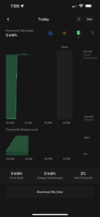wwhitney
Active Member
Except that is false. If it's grid-tied, it operates in parallel with the grid, and only software is keeping it from exporting. Such a system requires PTO.a tiny grid tied solar charged backup battery system (not Tesla) which claims not to need utility permission, because it is configured to never exports solar to the grid.
Cheers, Wayne



